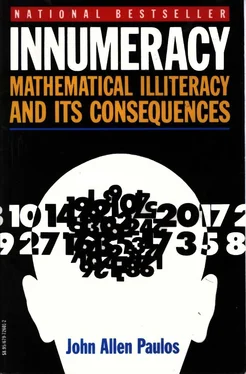John Paulos - INNUMERACY - Mathematical Illiteracy and Its Consequences
Здесь есть возможность читать онлайн «John Paulos - INNUMERACY - Mathematical Illiteracy and Its Consequences» весь текст электронной книги совершенно бесплатно (целиком полную версию без сокращений). В некоторых случаях можно слушать аудио, скачать через торрент в формате fb2 и присутствует краткое содержание. Жанр: Математика, Математика, на английском языке. Описание произведения, (предисловие) а так же отзывы посетителей доступны на портале библиотеки ЛибКат.
- Название:INNUMERACY: Mathematical Illiteracy and Its Consequences
- Автор:
- Жанр:
- Год:неизвестен
- ISBN:нет данных
- Рейтинг книги:5 / 5. Голосов: 1
-
Избранное:Добавить в избранное
- Отзывы:
-
Ваша оценка:
- 100
- 1
- 2
- 3
- 4
- 5
INNUMERACY: Mathematical Illiteracy and Its Consequences: краткое содержание, описание и аннотация
Предлагаем к чтению аннотацию, описание, краткое содержание или предисловие (зависит от того, что написал сам автор книги «INNUMERACY: Mathematical Illiteracy and Its Consequences»). Если вы не нашли необходимую информацию о книге — напишите в комментариях, мы постараемся отыскать её.
Topics include probability and coincidence, the birthday problem, innumeracy in pseudoscience, and statistics and trade-offs in society.
INNUMERACY: Mathematical Illiteracy and Its Consequences — читать онлайн бесплатно полную книгу (весь текст) целиком
Ниже представлен текст книги, разбитый по страницам. Система сохранения места последней прочитанной страницы, позволяет с удобством читать онлайн бесплатно книгу «INNUMERACY: Mathematical Illiteracy and Its Consequences», без необходимости каждый раз заново искать на чём Вы остановились. Поставьте закладку, и сможете в любой момент перейти на страницу, на которой закончили чтение.
Интервал:
Закладка:
Another widespread misconception is that numbers depersonalize or somehow diminish individuality. There is of course a legitimate concern about reducing complicated phenomena to simple numerical scales or statistics. Fancy mathematical terms and reams of statistical correlations and computer printouts do not in themselves produce understanding, social scientists' claims notwithstanding. Reducing a complex intelligence or the economy to numbers on a scale, whether I.Q. or GNP, is myopic at best and many times simply ludicrous.
That said, objections to being identified for special purposes by number (social security, credit cards, etc.) seem silly. If anything, a number in these contexts enhances individuality; no two people have the same credit-card number, for example, whereas many have similar names or personality traits or socioeconomic profiles. (I personally use my middle name-John Allen Paulos-to keep the masses from confusing me with the Pope.)
I'm always amused by commercials for banks which tout their personalized service, which service amounts to a poorly trained and badly paid cashier saying "Good morning" and then promptly fouling up your transaction. I'd rather go to a machine which knows me by some code word but on whose operating programs a team of software writers has painstakingly worked for months.
One objection I do have to identification numbers is their excessive length. An application of the multiplication principle shows that a nine-digit number or a six-letter sequence is of more than adequate length to distinguish every person in the country (10 9is a billion, while 26 6is more than 300 million). Why do department stores or suburban water companies find it necessary to assign account numbers with twenty or more symbols?
Writing of numbers and individuation reminds me of companies which will name a star after anyone who pays a $35 fee. So that the companies can wrap themselves in some sort of official cloak, the names are recorded in books which are registered in the Library of Congress. The companies generally advertise around Valentine's Day, and judging from their longevity they must be doing a fairly good business. A related and equally silly business idea I had was to "officially" associate a number with anyone who pays a $35 fee. A certificate would be sent to subscribers and a book with their names and cosmic numbers would be registered in the Library of Congress. There might even be a sliding scale, with perfect numbers selling at a premium and prime numbers going for more than nonperfect composite numbers, etc. I would get rich selling numbers.
Yet another misperception people have of mathematics is that it is limiting, and somehow opposed to human freedom. If they accept certain statements and then are shown that some other unpleasant statements follow from them, they associate the unpleasantness of the conclusions with the vehicle of their expression.
In this very weak sense, of course, mathematics is constraining, as is all reality, but it has no independent power to coerce. If one accepts the premises and definitions, one must accept what follows from them, but one can frequently reject premises or refine definitions or choose a different mathematical approach. In this sense, mathematics is just the opposite of constraining; it is empowering, and at the service of anyone who cares to use it.
Consider the following example, which illustrates the way we use mathematics but are not bound by it. Two men bet on a series of coin flips. They agree that the first to win six such flips will be awarded $100. The game, however, is interrupted after only eight flips, with the first man leading 5 to 3. The question is: How should the pot be divided? One might say that the first man should be awarded the full $100, because the bet was all or nothing and he was leading. Or one could reason instead that the first man should receive 5/ 8of the pot and the other one the remaining 3/ 8because the score was 5 to 3. Alternatively, it might be argued that because the probability of the first man's going on to win can be computed to be 7/ 8(the only way the second man could have won is by winning three flips in a row, a feat with probability 1/ 8= 1/ 2x 1/ 2x 1/ 2), the first man should receive 7/ 8of the pot to 1/ 8for the second man. (This incidentally was Pascal's solution to this, one of the first problems in probability theory.) Rationales for still other ways to apportion the money are possible.
The point is that the criteria for deciding on any one of these divisions are nonmathematical. Mathematics can help determine the consequences of our assumptions and values, but we, not some mathematical divinity, are the origin of these assumptions and values.
Nevertheless, mathematics is often seen as a spiritless affair. Many people believe that determining the truth of any mathematical statement is merely a matter of mechanically plugging into some algorithm or recipe which will eventually yield a yes or a no answer, and that given a reasonable collection of basic axioms, every mathematical statement is either provable or unprovable. Mathematics in this view is cut-and-dried and calls for nothing so much as mastery of the requisite algorithms, and unlimited patience.
The Austrian-American logician Kurt Gödel brilliantly refuted these facile assumptions by demonstrating that any system of mathematics, no matter how elaborate, will of necessity contain statements which can be neither proved nor disproved within the system. This and related results by logicians Alonzo Church, Alan Turing, and others have deepened our understanding of mathematics and its limitations. Given our concerns here, however, it's sufficient to note that not even theoretically is mathematics mechanical or complete.
Though related to these abstract considerations, the mistaken belief in the mechanical nature of mathematics generally takes more prosaic forms. Mathematics is often viewed as a subject for technicians, and mathematical talent is confused with rote skills, elementary programming ability, or speed of calculation. In a curious way, many people simultaneously exalt and dismiss mathematicians and scientists as impractical whizzes. Consequently, we frequently find senior mathematical, engineering, and scientific people ardently wooed by industry and then subordinated to newly minted M.B.A.s and accountants.
One other prejudice people have about mathematics is that its study somehow diminishes one's feeling for nature and the "big" questions. Since this position is frequently expressed (for example, by Whitman at the beginning of this chapter), but rarely argued for, it's difficult to refute. It makes as much sense as believing that a technical knowledge of molecular biology will render a person unappreciative of the mysteries and complexities of life. Too often, this concern for the big picture is simply obscurantist and is put forward by people who prefer vagueness and mystery to (partial) answers. Vagueness is at times necessary and mystery is never in short supply, but I don't think they're anything to worship. Genuine science and mathematical precision are more intriguing than are the "facts" published in supermarket tabloids or a romantic innumeracy which fosters credulity, stunts skepticism, and dulls one to real imponderables.
DIGRESSION: A LOGARITHMIC SAFETY INDEX
Several years ago, supermarkets began to use unit pricing (cents per pound, per fluid ounce, etc.) to give consumers a uniform scale with which to measure value. If the price of dog food and cake mix can be rationalized, why can't some sort of rough "safety index" be devised which allows us to gauge how safe various activities, procedures, and illnesses are? What I'm suggesting is a kind of Richter scale which the media could use as a shorthand for indicating degrees of risk.
Like the Richter scale, the proposed index would be logarithmic, so what follows is a little detour to review for the innumerate those dreaded monsters from high school algebra: logarithms. The logarithm of a number is simply the power to which 10 must be raised to equal the number in question. The logarithm of 100 is 2 because 10 2= 100; the logarithm of 1,000 is 3 because 10 3= 1,000; and the logarithm of 10,000 is 4 because 10 4= 10,000. For numbers between powers of 10, the logarithm is between the two nearest powers of 10. For example, the logarithm of 700 is between 2, the logarithm of 100, and 3, the logarithm of 1,000; it happens to be about 2.8.
Читать дальшеИнтервал:
Закладка:
Похожие книги на «INNUMERACY: Mathematical Illiteracy and Its Consequences»
Представляем Вашему вниманию похожие книги на «INNUMERACY: Mathematical Illiteracy and Its Consequences» списком для выбора. Мы отобрали схожую по названию и смыслу литературу в надежде предоставить читателям больше вариантов отыскать новые, интересные, ещё непрочитанные произведения.
Обсуждение, отзывы о книге «INNUMERACY: Mathematical Illiteracy and Its Consequences» и просто собственные мнения читателей. Оставьте ваши комментарии, напишите, что Вы думаете о произведении, его смысле или главных героях. Укажите что конкретно понравилось, а что нет, и почему Вы так считаете.












